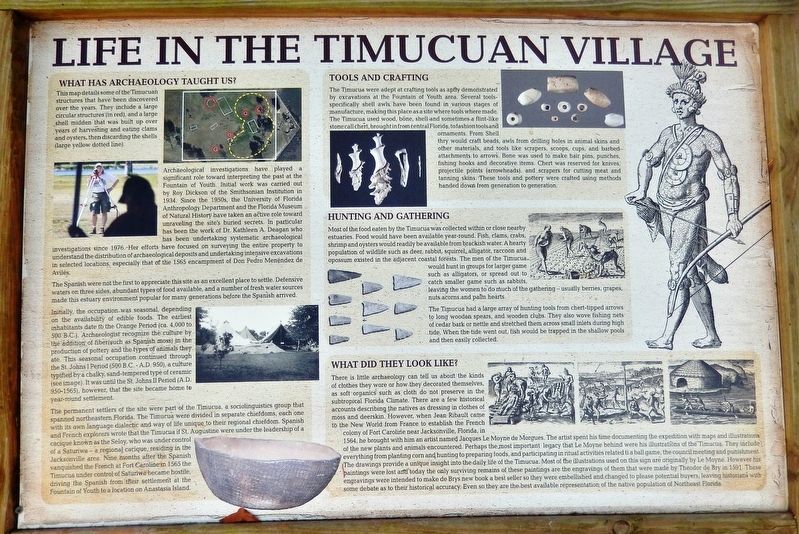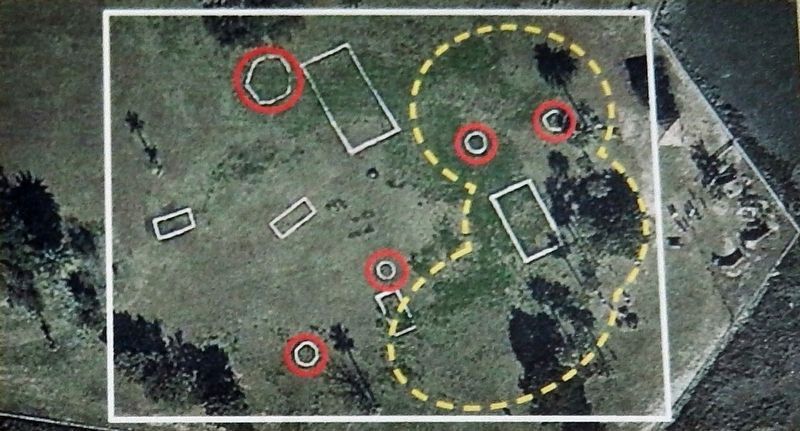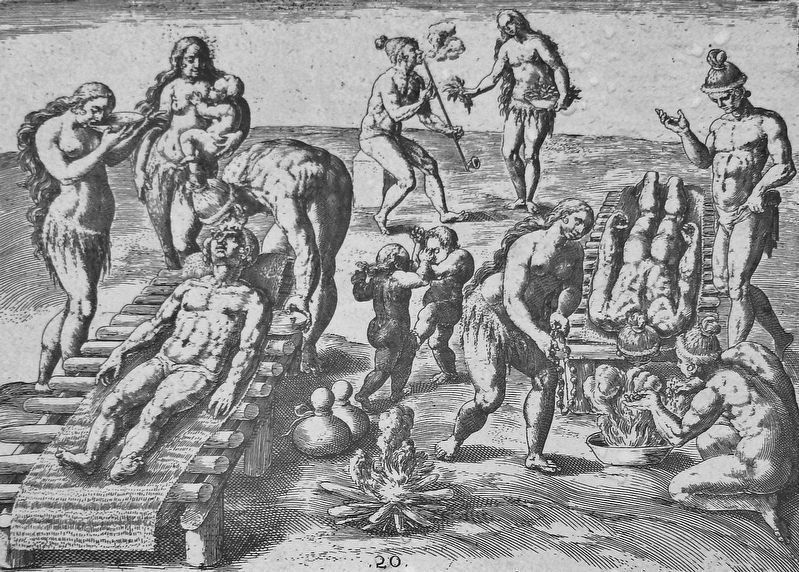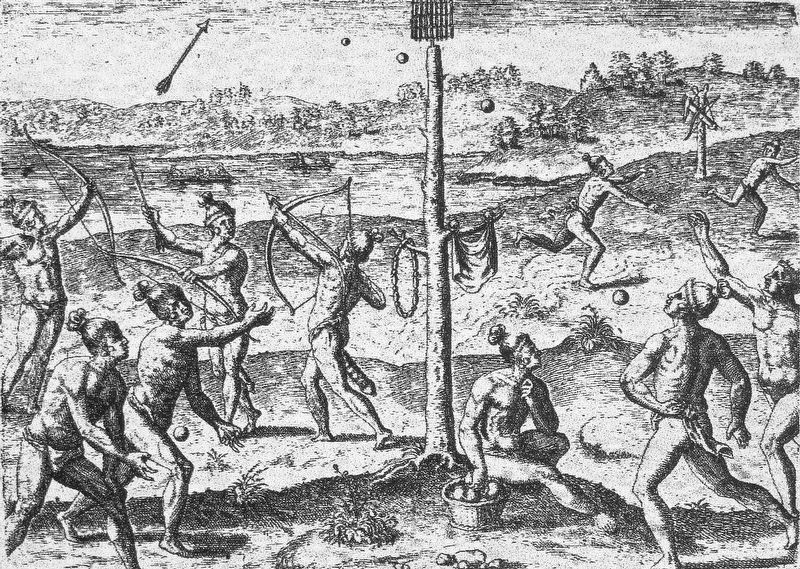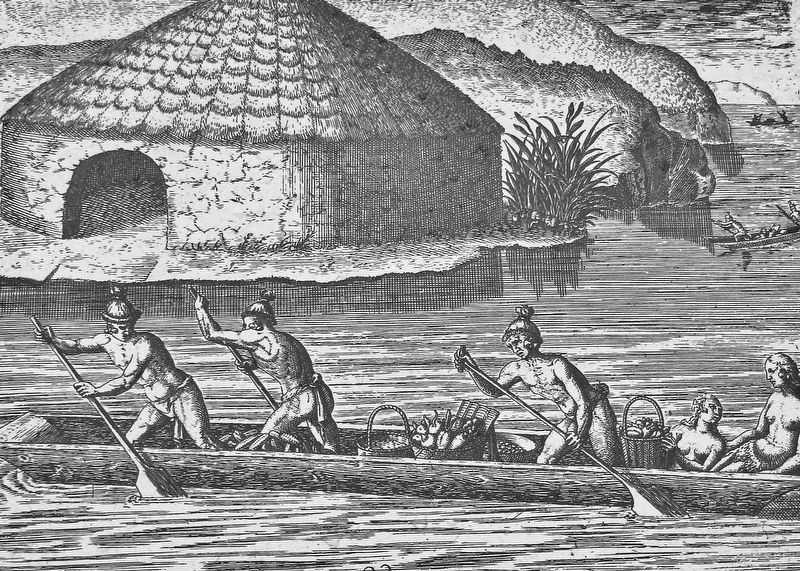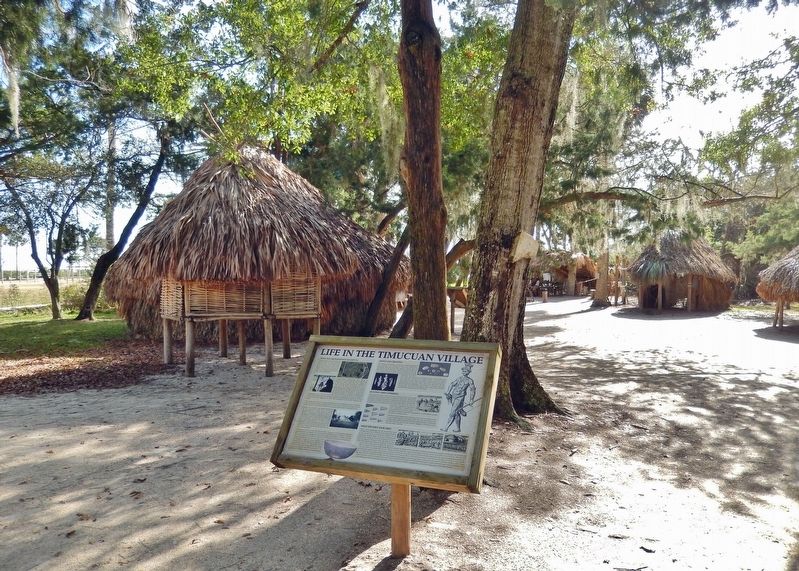Historic District in St. Augustine in St. Johns County, Florida — The American South (South Atlantic)
Life in the Timucuan Village
What has Archaeology Taught Us?
This map details some of the Timucuan structures that have been discovered over the years. They include large circular structures (in red), and a large shell midden that was built up over years of harvesting and eating clams and oysters, then discarding the shells (large yellow dotted line).
Archaeological investigations have played a significant role toward interpreting the past at the Fountain of Youth. Initial work was carried out by Roy Dickson of the Smithsonian Institution in 1934. Since the 1950s, the University of Florida Anthropology Department and the Florida Museum of Natural History have taken an active role toward unraveling the site's buried secrets. In particular has been the work of Dr. Kathleen A. Deagan who has been undertaking systematic archaeological investigations since 1976. Her efforts have focused on surveying the entire property to understand the distribution of archaeological deposits and undertaking intensive excavations in selected locations, especially that of the 1565 encampment of Don Pedro Menéndez de Avilés.
The Spanish were not the first to appreciate this site as an excellent place to settle. Defensive waters on three sides, abundant types of food available, and a number of fresh water sources made this estuary environment popular for many generations before the Spanish arrived.
Initially, the occupation was seasonal, depending on the availability of edible foods. The earliest inhabitants date to the Orange Period (ca. 4,000 to 500 B.C.). Archaeologists recognize the culture by the addition of fiber (such as Spanish moss) in the production of pottery and the types of animals they ate. This seasonal occupation continued through the St. Johns I Period (500 B.C. - A.D. 950), a culture typified by a chalky, sand-tempered type of ceramic (see image). It wasn’t until the St. Johns II Period (A.D. 950-1565), however, that the site became home to year-round settlement.
The permanent settlers of the site were part of the Timucua, a sociolinguistics group that spanned northeastern Florida. The Timucua were divided in separate chiefdoms, each one with its own language dialectic and way of life unique to their regional chiefdom. Spanish and French explorers wrote that the Timucua of St. Augustine were under the leadership of a cacique known as the Seloy, who was under control of a Saturiwa — a regional cacique, residing in the Jacksonville area. Nine months after the Spanish vanquished the French at Fort Caroline in 1565 the Timucua under control of Saturiwa became hostile, driving the Spanish from their settlement at the Fountain of Youth to a location on Anastasia Island.
Tools and Crafting
The Timucua were adept at crafting tools as aptly demonstrated by excavations at the Fountain of Youth area. Several tools, specifically shell awls, have been found in various stages of manufacture, making this place a site where tools were made. The Timucua used wood, bone, shell and sometimes a flint-like stone call chert, brought in from central Florida, to fashion tools and ornaments. From Shell they would craft beads, awls from drilling holes in animal skins and other materials, and tools like scrapers, scoops, cups, and barbed attachments to arrows. Bone was used to make hair pins, punches, fishing hooks and decorative items. Chert was reserved for knives, projectile points (arrowheads), and scrapers for cutting meat and tanning skins. These tools and pottery were crafted using methods handed down from generation to generation.
Hunting and Gathering
Most of the food eaten by the Timucua was collected within or close nearby estuaries. Food would have been available year-round. Fish, clams, crabs, shrimp and oysters would readily be available from brackish water. A hearty population of wildlife such as deer, rabbit, squirrel, alligator, raccoon and opossum existed in the adjacent coastal forests. The men of the Timucua would hunt in groups for larger game such as alligators, or spread out to catch smaller game such as rabbits, leaving the women to do much of the gathering — usually berries, grapes, nuts acorns and palm hearts.
The Timucua had a large array of hunting tools from chert-tipped arrows to long wooden spears, and wooden clubs. They also wove fishing nets of cedar bark or nettle and stretched them across small inlets during high tide. When the tide went out, fish would be trapped in the shallow pools and then easily collected.
What Did They Look Like?
There is little archaeology can tell us about the kinds of clothes they wore or how they decorated themselves, as soft organics such as cloth do not preserve in the subtropical Florida Climate. There are a few historical accounts describing the natives as dressing in clothes of moss and deerskin. However, when Jean Ribault came to the New World from France to establish the French colony of Fort Caroline near Jacksonville, Florida, in 1564, he brought with him an artist named Jacques Le Moyne de Morgues. The artist spent his time documenting the expedition with maps and illustrations of the new plants and animals encountered. Perhaps the most important legacy that Le Moyne left behind were his illustrations of the Timucua. They include everything from planting corn and hunting to preparing foods, and participating in ritual activities related to a ball game, the council meeting and punishment. The drawings provide a unique insight into the daily life of the Timucua. Most of the illustrations used on this sign are originally by Le Moyne. However, his paintings were lost and today the only surviving remains of these paintings are the engravings of them that were made by Theodor de Bry in 1591. These engravings were intended to make de Bry’s new book a best seller so they were embellished and changed to please potential buyers, leaving historians with some debate as to their historical accuracy. Even so they are the best available representation of the native population of Northeast Florida.
Topics. This historical marker is listed in these topic lists: Anthropology & Archaeology • Colonial Era • Native Americans • Settlements & Settlers.
Location. 29° 54.41′ N, 81° 18.914′ W. Marker is in St. Augustine, Florida, in St. Johns County. It is in the Historic District. Marker can be reached from Williams Street east of Magnolia Avenue. Marker is located along the interpretive trail in Ponce de León's Fountain of Youth Archaeological Park. Touch for map. Marker is at or near this postal address: 11 Magnolia Avenue, Saint Augustine FL 32084, United States of America. Touch for directions.
Other nearby markers. At least 8 other markers are within walking distance of this marker. Mission Life in Nombre de Dios (here, next to this marker); Timucuan Style Dugout Canoe (a few steps from this marker); The Timucuan Home (a few steps from this marker); The Original Mission Church (a few steps from this marker); 1770s British Anchor (a few steps from this marker); Chief Saturiwa (within shouting distance of this marker); Copper Cauldron (within shouting distance of this marker); 4,000 BC (within shouting distance of this marker). Touch for a list and map of all markers in St. Augustine.
More about this marker. There are two identical copies of this marker: one on the west side of the Timucuan Village exhibit, and one about 20 yards east on the east side of the exhibit.
Related markers. Click here for a list of markers that are related to this marker. Ponce de León's Fountain of Youth Archaeological Park
Credits. This page was last revised on December 29, 2021. It was originally submitted on December 26, 2021, by Cosmos Mariner of Cape Canaveral, Florida. This page has been viewed 248 times since then and 59 times this year. Photos: 1, 2, 3, 4, 5, 6. submitted on December 27, 2021, by Cosmos Mariner of Cape Canaveral, Florida.
